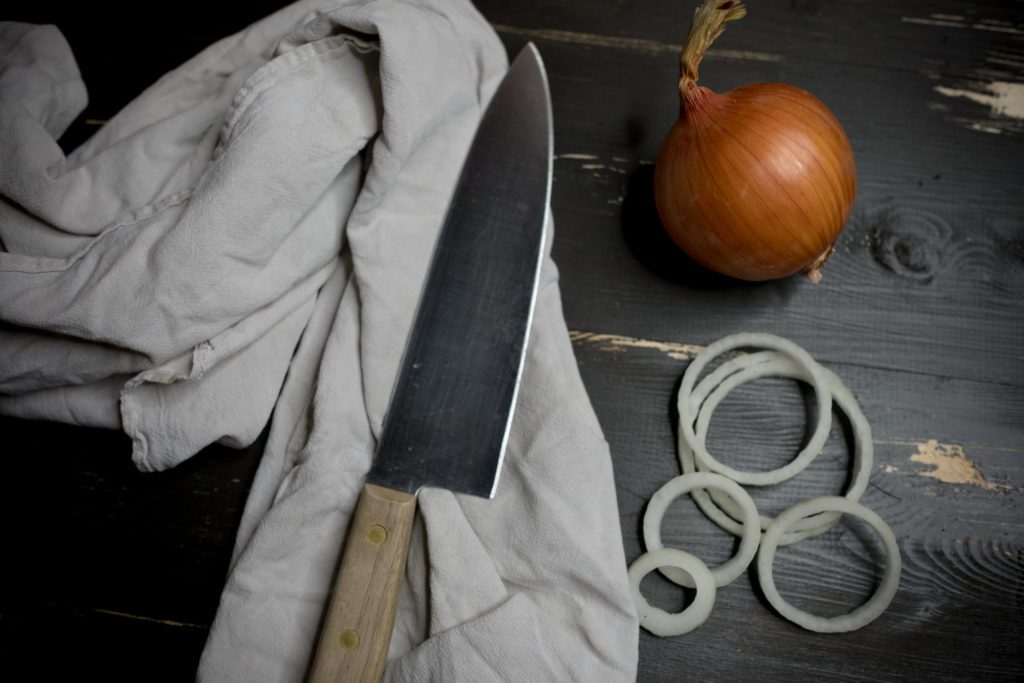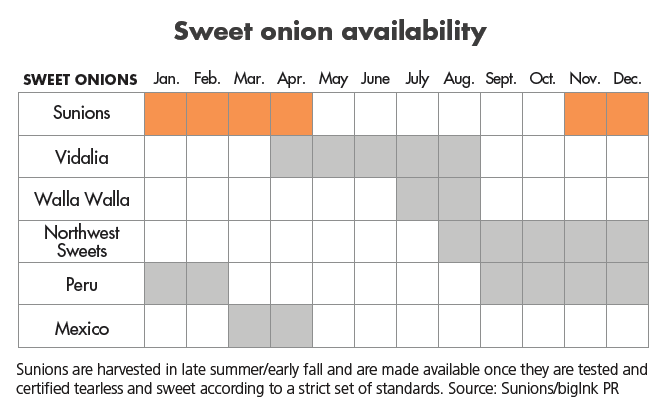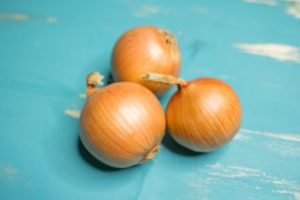

Apr 10, 2018Bayer debut of consumer-friendly Sunions limited
Marketed as “tearless” and sweet-tasting, a new onion variety developed by Bayer CropScience hit shelves in January.
Sold under the Sunions brand, the onion was grown commercially by just three growers in two states for its first season: Hartley’s Best Onions and L&L Ag in Washington, and Peri Sons Farms in Nevada. Roughly, 200 total acres are being grown, and the yields have been about 900 cwt per acre. Despite the limited first season, Bayer executives say they hope it will be a game-changer for the vegetable – not to mention for kitchens everywhere.
“We think this variety certainly has global appeal,” said Jeff Boettge. global head of marketing and sales at Bayer CropScience Vegetable Seeds. “Growers are excited. Everybody gets excited and wants to be a part of something new.”
Boettge and Lyndon Johnson, crop manager for onions at Bayer Vegetable Seeds, said they’re waiting to see how the market reacts to Sunions before deciding whether to ramp up production.
“As the production demand increases over time, then we’ll look at other avenues for distribution,” Boettge said. “This is a variety that’s not easy to grow and not widely adapted to a variety of growing areas.”
A class of its own
Onion growers often distinguish between long- and short-day onions. Short-day onions need only 10-12 hours of daylight to bulb up. Because of their higher water content, they generally do not store well. Most major sweet onion varieties are short-day onions.
Long-day onions, though, generally need 14-16 hours of daylight to bulb up, and although they store well, noxious gases such as puruvaic acid build up in the vegetable during storage.
Sunions are a long-day storage onion, said Johnson, who’s project leader for Bayer’s newest onion. He hesitated to compare it any further to other traditional onion varieties.
“It’s creating a whole new category in the long-day onions,” he said. Unlike most long-day onions, Sunions grow sweeter instead of more pungent, more laden with tear-inducing pyruvates.
“This one goes the opposite way, and it’s the only one I know that does this,” he said. “I’ve been in the onion market for 35 years. This is a game-changer, in my opinion.”
Right now, Johnson said, batches of Sunions aren’t commercially released until they’re certified to pass taste panels. Typically, they are harvested in late summer or early fall, and reach their mature sweet flavor in November. If stored away from the light in a cool, dry place, they can retain their eating quality for up to six months, or through April.
The onions are being marketed not only for cooking but also for raw consumption, on hamburgers and even just with dips.
“That’s one of the concepts we have in mind, is to make this like a snacking vegetable,” Boettge said.
Apparently, the tearless trait is already on consumers’ radar: “How can you cut an onion without crying?” is the most commonly asked question of the National Onion Association. Consumers’ response could determine how much of the vegetables are grown in the future.
“We’re going to monitor the response,” Johnson said. “We’re going to see how well this is accepted in the consumer market and retail. I’m sure we’ll have plans to grow it quickly.”
“This is going to be something the growers are going to evaluate at the end of the season, and if they want to increase their Sunion market, then they can grow some more acres.”
Practicing patience
Bayer CropScience has had to exercise a certain amount of corporate patience in releasing a variety that’s come at the expense of multiple millions of dollars of research and development, and which researchers have chased for decades.
“This onion is the product of more than 30 years of research and development to grow an onion that actually decreased in pungency during storage,” Sunions breeder Rick Watson said.
In 1985, a 23-year-old Boettge was working his first professional job, assisting a scientist with the USDA onion and carrots breeding improvement program. He had no idea the research would lead to a “game-changer” more than 30 years later.
“Who knew?” he said.
The release’s time frame has been stretched out not only by the desire to get the onion right, but to be prepared for long-term future demand if the onion is a hit.
“One of the things you learn as a seed company is you need to have a sufficient number of seeds to meet the market demand,” Boettge said. Farming seeds — like any other crop – contains a certain amount of risk.
Another delay was making sure the growers could reliably grow the crop and get it out to customers in the right condition, Boettge said.
While Sunions seem to have a superior trait for consumers, they’re not without some genetic weakness. Boettge would like to see improvements in yields, disease resistance, and adaptation to a wider variety of climates. “There’s certainly some improvements we want to make,” he said.
Boettge said there’s a good comparison to be made between Sunions and the breakout apple variety Honeycrisp, which was a hit with consumers, but difficult to grow.
“Everything … comes at a trade-off,” he said.
– Stephen Kloosterman, VGN Assistant Editor
Photos: Sunions/bigInk PR

















